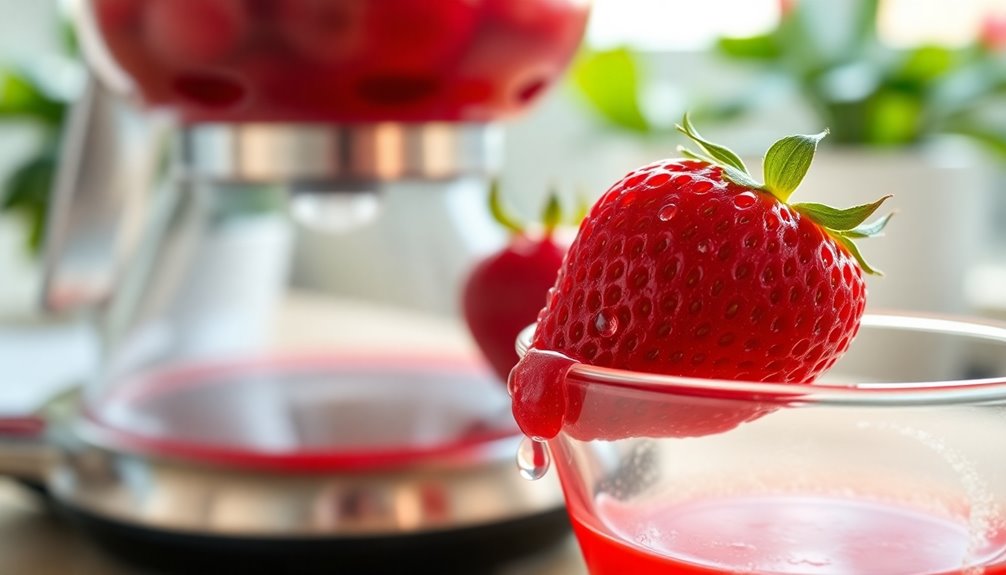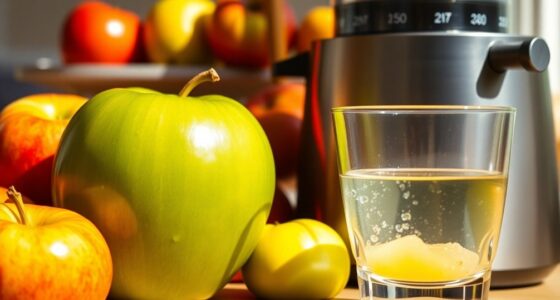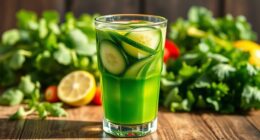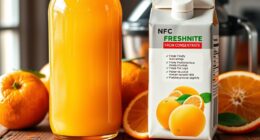To juice strawberries, first choose fresh, ripe berries that are plump and fragrant. Wash them thoroughly and remove the green stems. Blend the strawberries in a high-speed blender until smooth. If you like, add a splash of lemon juice for tang. Taste your juice and sweeten it with honey or maple syrup, if needed. For the best flavor and nutrition, drink it right away, but you can also refrigerate or freeze it for later enjoyment. You'll discover even more tips ahead.
Key Takeaways
- Select fresh, ripe strawberries that are plump, red, and fragrant for the best flavor.
- Wash strawberries thoroughly, remove green stems, and ensure cleanliness for optimal juice quality.
- Use a high-speed blender or juicer to blend strawberries into a smooth mixture, optionally adding lemon juice for tang.
- Taste the juice and add honey or maple syrup to enhance sweetness without overpowering the strawberry flavor.
- Consume the juice immediately or refrigerate for 2-3 days, or freeze for longer storage.

Juicing strawberries is a simple and rewarding process that brings out their vibrant flavor and nutrition. To start, you'll want to choose fresh, ripe strawberries. Look for berries that are plump, red, and fragrant, as these will provide the best flavor for your sweet strawberry juice.
Begin by thoroughly washing the strawberries to remove any dirt or pesticides, and then remove the green stems. This will ensure that you're working with clean, delicious fruit.
Next, you'll need a high-speed blender or juicer to blend the strawberries into a smooth mixture. If you want to enhance the flavor of your fresh strawberry juice, consider adding a splash of lemon juice. Not only does this add a delightful tang, but it also helps preserve the juice, keeping it fresh longer.
Blend the strawberries until they're completely smooth, which usually takes just a minute or two. The longer you blend, the more you'll extract their juicy goodness.
If you prefer a smoother texture, you can strain the juice afterward. This step is optional, but straining the blended mixture through a nut milk bag or cheesecloth removes the pulp, resulting in a clearer juice. However, if you enjoy the fiber and texture, feel free to skip this step. It's all about your personal preference.
Once you've got your fresh strawberry juice ready, you can sweeten it if needed. Depending on how sweet your strawberries are, you mightn't need any additional sweeteners. But if you want a little extra sweetness, consider adding honey or maple syrup.
Start with a small amount, then taste and adjust to your liking. Remember, the aim is to enhance the natural flavor of the strawberries without overpowering it.
After preparing your sweet strawberry juice, it's best to consume it immediately for maximum nutritional benefits. Fresh juice contains vitamins and antioxidants that can diminish over time.
If you can't drink it right away, you can refrigerate it for up to 2-3 days. Just be sure to store it in an airtight container to maintain its freshness. Alternatively, you can freeze the juice for longer storage. Pour it into ice cube trays or freezer-safe containers, and you'll have a refreshing treat ready for later.
Juicing strawberries isn't just about enjoying a delicious drink; it's also a way to incorporate more nutrition into your diet. With their vibrant color and refreshing flavor, fresh strawberry juice is a delightful addition to any meal or snack.
Frequently Asked Questions
How Do You Get Strawberries to Release Juice?
To get strawberries to release juice, start with ripe, fresh berries. If they're overripe or under-ripe, you won't get much juice.
Wash them in a vinegar-water mixture for better flavor.
Then, blend them thoroughly in a high-speed blender to break down their cell walls.
Adding a splash of lemon or lime juice can enhance the flavor and help extract more juice.
For the best results, consider using a juicer to maximize yield.
Are Strawberries Good for Juicing?
Absolutely, strawberries are great for juicing! Did you know that they contain about 91% water? This high water content not only helps you extract juice easily but also makes for a refreshing drink.
Plus, their rich vitamin C and antioxidant levels boost your health. When you juice fresh, ripe strawberries, you get a naturally sweet flavor without needing added sugar.
How to Get Juice Out of a Strawberry?
To get juice out of a strawberry, you'll want to start by washing and removing the green stems.
Then, blend the strawberries until they're smooth, adding a bit of water or sweetener if you like.
For a smoother juice, strain the mixture through a nut milk bag or cheesecloth.
Alternatively, you can use a juicer for a quick extraction.
Enjoy your fresh strawberry juice right away for the best flavor and nutrients!
How Do You Get Strawberry Juice Out of the Top?
Imagine you're in a medieval kitchen, trying to extract juice from strawberries. To get juice out of the tops, avoid using those bitter green parts. Instead, focus on the fruit itself.
Cut off the tops and blend the strawberries thoroughly until smooth. You can then strain the mixture for a smoother result.
If you've a juicer, simply feed the strawberries in, and let it separate the juice from the pulp effortlessly.
Conclusion
Juicing a strawberry isn't just about the delicious flavor; it's a little reminder of summer picnics and laughter with friends. As you enjoy that sweet, vibrant juice, you might recall that time you stumbled upon a hidden strawberry patch, or the first time you tried strawberry lemonade. It's funny how something as simple as juicing can spark such fond memories. So, go ahead—savor the juice and let those delightful moments wash over you with every sip!
Cindy thoroughly researches juicing trends, techniques, and recipes to provide readers with practical advice and inspiration. Her writing style is accessible, engaging, and designed to make complex concepts easy to understand. Cindy’s dedication to promoting the advantages of juicing shines through her work, empowering readers to make positive changes in their lives through the simple act of juicing.











